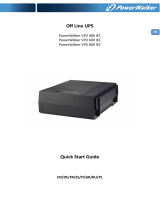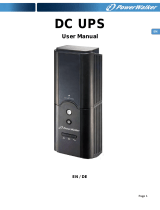1-1 TUV Safety Instruction
• Please observe the following precautions to ensure personnel safety and
reliable equipment observation:
• The sound pressure level at the operator’s position according to IEC
704-1:1982 is equal to or less than 70dB(A).
For installation:
• The unit should be installed by service personnel only.
• Upon installation, it should be ensured that the sum of leakage current
of the UPS and the connected equipment does not exceed 3.5mA.
• The socket outlet should be located near the equipment and
easy to access.
Other safety instructions:
• The UPS contains electrical voltage which makes it potentially hazardous.
All repairs should be performed by qualified service personnel. The UPS
has its own internal energy source (battery). The output receptacles may
be alive even when the UPS is not connected.
• When replacing batteries, always use the same type and quantity as the
previous one. Batteries of GP1270-F2(CSB 12V/7AH*2) for 450VA and
700VA; GP12110-F2(CSB 12V/11AH*2) for 1000VA, and GP12170-B1
(CSB 12V/17AH*2) for 1400VA models.
• Do not dispose the battery or batteries in fire as they may explode.
• Do not open or mutilate the battery or batteries as released electrolyte
is toxic and harmful to skin and eyes.
• A battery can present a risk of electric shock and high short circuit current.
The following precautions should be observed when working on batteries:
• Remove watches, rings, or other metal objects.
• Use tools with insulated handles.
• The equipment is to be operated by fully trained personnel.
1. Important Safety Instructions
1
En























